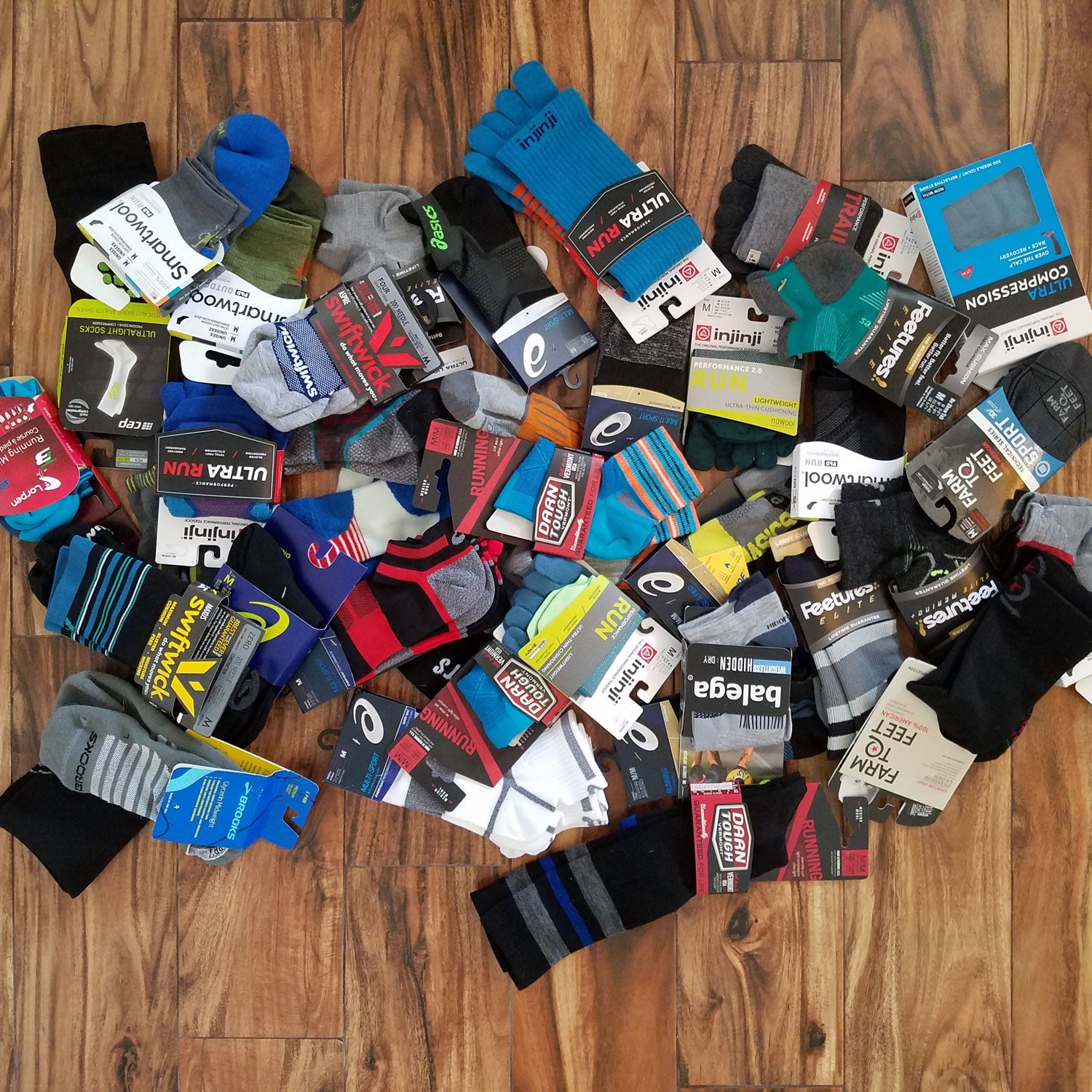For the past several months, we’ve been searching for the perfect pair of running socks: socks that wick sweat, don’t stink or cause blisters, and feel good on the road and trail. To find these unicorn socks, a group of six experienced runners tested 59 pairs of socks from 16 top running brands in locations around the world. Ten pairs of socks stood out, and one pair emerged as a unanimous favorite: , a merino-polyester blend that was tough, comfortable, quick-drying, and nonstinky.
Our Favorite Running Socks
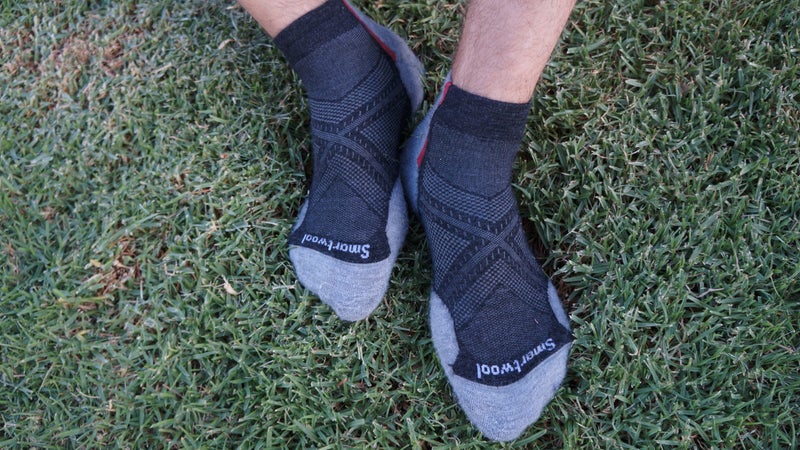
Smartwool PhD Run Light Elite ($18)
The is the only sock that made the top end of every tester’s��list. The Run Light Elite, which comes in both mid-crew and no-show cuts, is a weave of merino wool, nylon, and a touch of elastane. It wicked better and dried faster than most of the 58 other socks we tested, seemingly regardless of weather or trail conditions. In A/B testing, when I’d wear a��different sock��on each foot to vet wicking ability more carefully, the Run Light Elite almost always felt drier. And once off my feet, it dried within minutes in direct sunlight, a perk for ultrarunners or anyone planning to take these socks on very long runs.
Smartwool gave the Run Light Elite a snug fit through the midfoot, which didn’t lose elasticity over the course of the test, and provided more material on the ball and heel, which I felt added a welcome amount of softness and protection underfoot��and should increase durability in high-abrasion areas. Like all merino socks, the Run Light Elite also resisted odor better than fully synthetic options.
On the subject of durability: wool socks are notorious for wearing out fast, but I’m confident in the Run Light Elite. I didn’t find any��holes during this test, and a pair of Run Light Elites I’ve been wearing since last year is still holding strong. That said, I did find signs of external pilling after a few washes, though it didn’t affect the socks’ functionality. I am further encouraged by Smartwool’s a two-year,��, although it’s not quite as good as merino-sock rival Darn Tough’s lifetime guarantee.
Given a choice, these are the socks I reach for. They’re soft, fast-wicking, quick-drying, durable, and comfortable for a long time regardless of conditions. Of the 59 models of socks we tested, Smartwool’s ��was the cream of the crop. Material:��52 percent merino wool, 45 percent nylon, 3 percent��elastane
��
Best Cushioned Running Socks
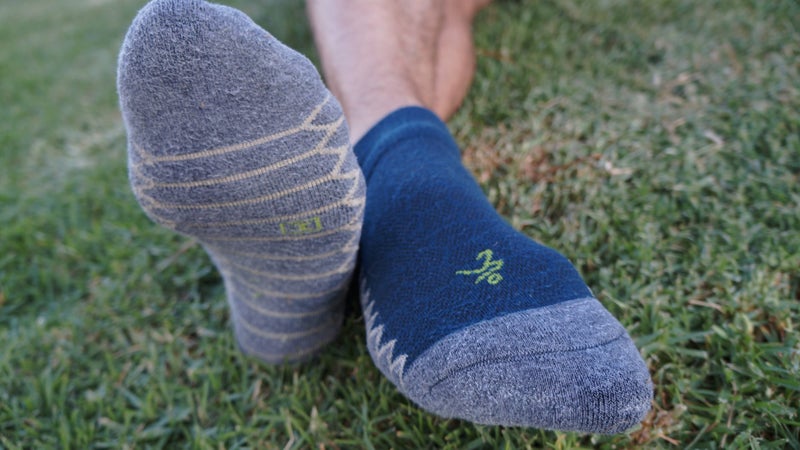
Balega Silver ($15)
Cushioned socks may not provide cushioning in the same way that your shoes do, but many runners like how they feel. And ��felt great. They’re plush, roomy, and comfortable—as one tester put it, they’re “the Cadillac of running socks.”
We liked that these socks were super stretchy, never bunching up or sliding down during runs. And��for very thick socks, the Silver’s polyester-nylon blend did an excellent job of wicking moisture, keeping our feet feeling cool and relatively dry even on warm days. The Silver’s antimicrobial silver treatment did seem to help fight odor, although it was even better at keeping the socks feeling fresh, allowing us to wear them a few times between washes if needed. Given how thick these socks are, I recommend trying them on first to be sure your shoes can handle the extra mass comfortably. Material: 75 percent Drynamix��polyester, 23 percent nylon, 2 percent elastane
Most Comfortable Running Socks
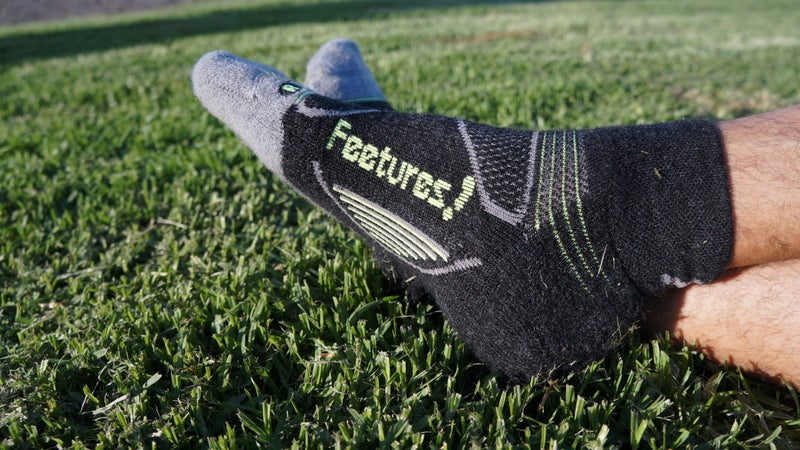
Feetures Merino+ Cushion ($17)
socks are smooth��and, as one tester put it, “soft as a newborn kitten.” The Merino+ Cushion is a thick��sock��suited for running in cooler temperatures and comes in crew, quarter, and no-show cuts. (If you run regularly in warm temps, thinner socks such as Balega’s Hidden Dry or Darn Tough’s Vertex Ultra-Light Cushion felt lighter and more comfortable in our testing, but not as soft as the Merino+ Cushion.)
Feetures used a couple of standard tactics to dial in the fit with the Merino+ Cushion: there are left and right cuts, and stretchy fabric in the arch helps��keep the Merino+ “from sliding and adds��a bit of support,” according to one tester.��Feetures has a lifetime guarantee, though as is common with most wool socks, the Merino+ Cushion had some superficial pilling after a few washes, which didn’t seem to affect their soft feel. Material: 37 percent rayon, 34 percent wool, 25 percent nylon, 4 percent spandex
Best Trail-Running Socks
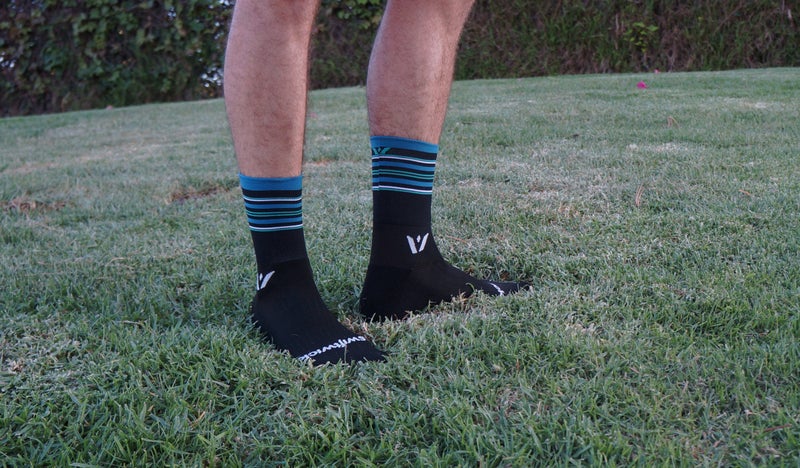
Swiftwick Aspire Four ($18)
Perhaps better known among cyclists, Swiftwick socks landed on every tester’s top-pick list, and the was a favorite among our trail runners. The selling point was a double-cuff construction that helped keep trail debris from getting into the sock and provided a little protection to the ankles. “Some crews can get itchy or fall down after long hours on the trail, but this was comfortable and stayed up well all day.” Another wrote that “the Aspire Four��is thin, compressively snug, and snaps well into place above the ankle.” A couple testers did find the upper sleeve to be tight, and it might not work as well for runners with big calves. Material: 67 percent nylon, 28 percent olefin, 5 percent spandex
Best Wicking Running Socks
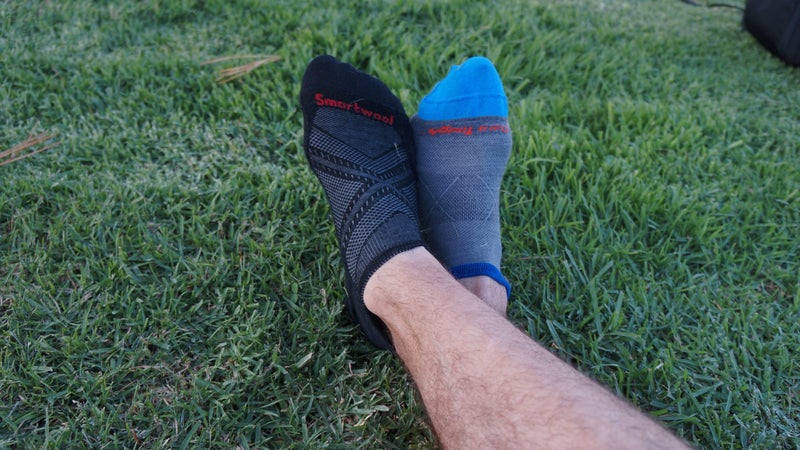
Smartwool PhD Run Ultra Light ($16) and Darn Tough Vertex Ultra-Light ($16)
In side-by-side testing, these socks were indistinguishable, probably because of their nearly identical wool-nylon blends. Even on runs when I was sweating hard, neither pair retained sweat, and they seemed to wick better than any other socks in the test, including the overall winner, the PhD Run Light Elite, which is thicker. Both socks are thin and skintight, and I found them perfect for runs when I wanted a close connection to my shoes. These were the socks I paired with my racing flats, up-tempo shoes, or technical trail shoes.
The only notable difference is that Darn Tough offers a lifetime, no-questions-asked guarantee, whereas Smartwool is limited to a two-years-and-we’ll-do-our-best-to-make-it-right��guarantee. I have no reason to doubt Smartwool’s sincerity, but I’ve personally returned two Darn Tough socks that developed holes. Sure enough, within a few weeks, brand-new socks arrived, no questions asked.
��
Best Compression Socks
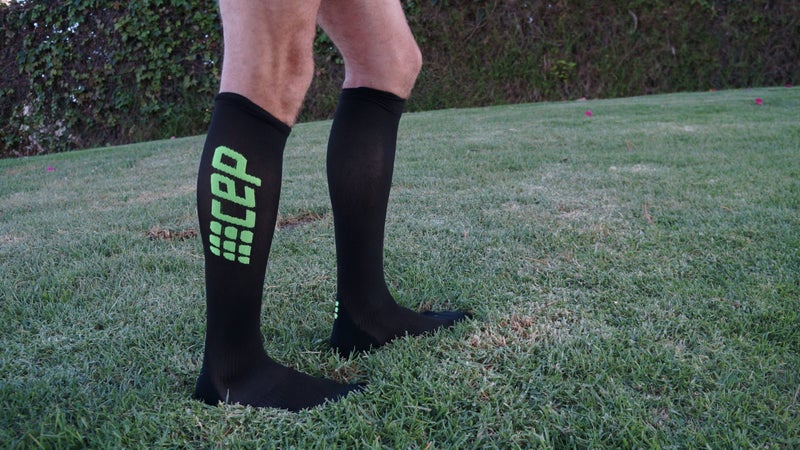
CEP Ultralight ($60)
Our testers’ favorite compression sock comes from German brand CEP. The Ultralight is made with an ultra-thin all-synthetic blend��that yielded a fit that was snug without being too constricting. As one tester put it, “The thinner material is breathable��but still equally effective at compression.” The Ultralight also got points for its seamless design and light padding in the foot.
We didn’t try to measure whether any of the compression socks in this test had actual performance benefits—there’s showing that compression socks may modestly improve performance and speed recovery—but rather evaluated comfort and wicking. The downside of compression socks is that they eventually lose��some of their��ability to compress. CEP estimates that the Ultralight will last between 150 to 200 uses, though our test didn’t last long enough to verify those figures, and it offers a six-month guarantee. Material:��60 percent polyamide,��25 percent��elastane, and 15 percent polypropylene
��
The Rest of the Test
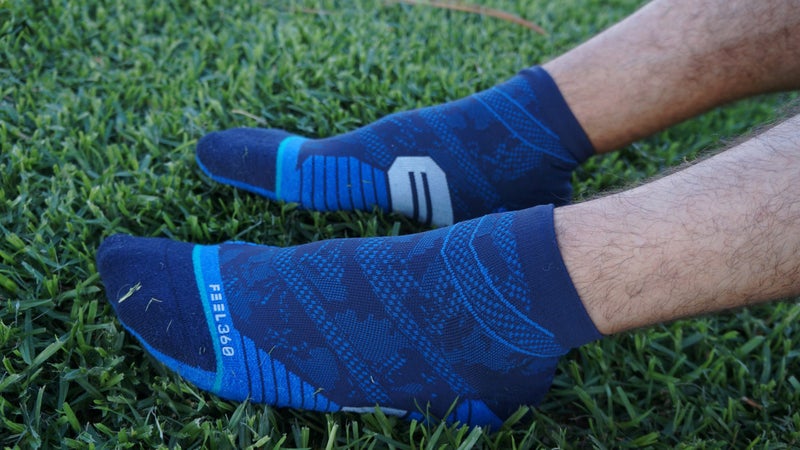
Stance Run 360 ($18)
I was a fan of the��’s tight, supportive, almost compressionlike fit. There’s a small amount of padding under the heel and toes, while the top is kept thin and breathable. With designated right and left socks, I ended up putting the wrong sock on the wrong foot half the time, but once I got them on correctly they fit well. Since they come in a bunch of styles and colors, I often wore them around town Saturday night and then again on Sunday’s long run. Material: 66 percent nylon, 24 percent polyester, 6 percent combed cotton, 4 percent��elastane
Darn Tough Vertex Ultra-Light Cushion ($17)
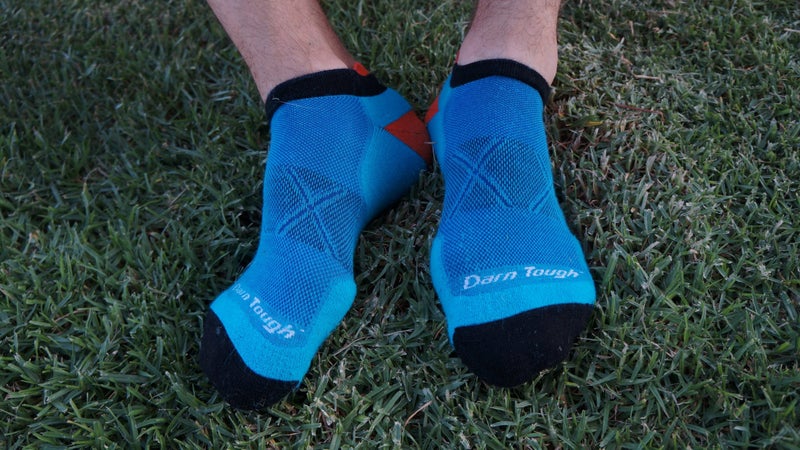
Darn Tough calls these socks��, though I would classify them more as a medium-cushioned sock—they fit somewhere between socks like the Feetures Merino+ Cushion and Smartwool’s PhD Run Ultra Light or Darn Tough’s Vertex Ultra-Light. I found them to be among��the best-fitting socks of the bunch, easy to put on with an immediate second-skin-like feeling. The test group reported that the material was comfortable and resisted the typical wool pilling. Material: 50 percent merino wool, 45 percent nylon, 5 percent Lycra spandex
Balega Hidden Dry ($13)
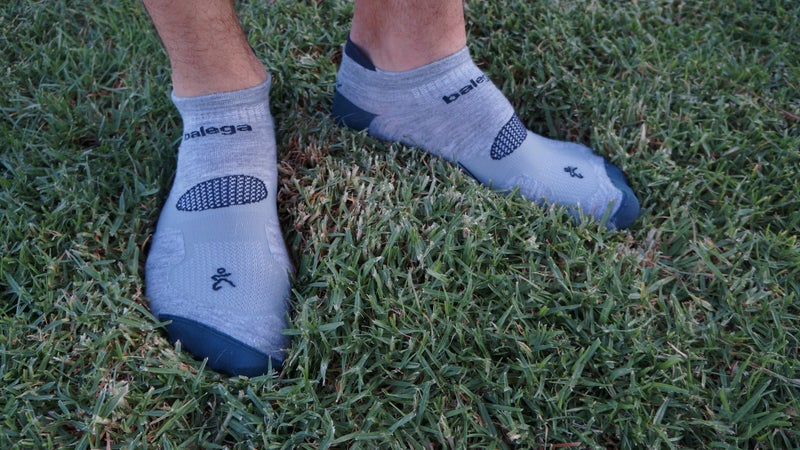
One of our fastest testers ��during her first marathon and ran an Olympic trials qualifier. Afterward, she said, “The heel doesn’t slip despite being so thin. I never had to stop and adjust my socks during the race, and I felt like the socks were working with me the whole time.” As an added bonus, at $13 these socks are among the least expensive we tested. Material: 43 percent��Drynamix��polyester, 25 percent��microfiber, 30 percent polyamide, 2 percent��elastane
How We Tested the Socks
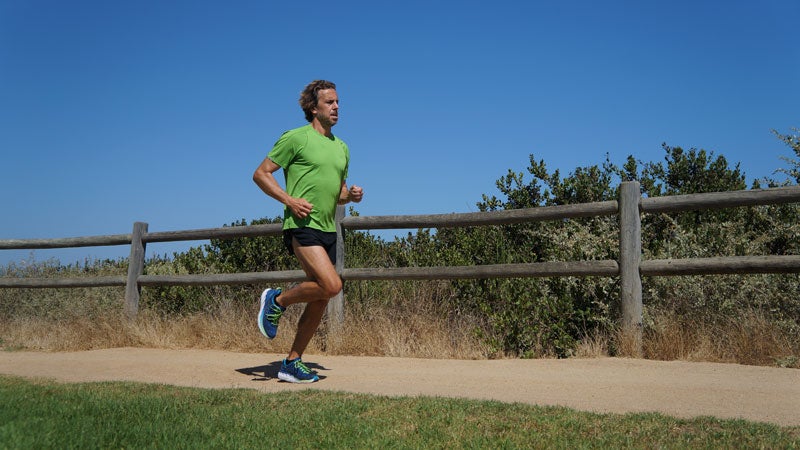
I’ve been a competitive runner for more than 25 years and a full-time running coach since 2014, when I founded . I’ve tested hundreds of running products, and I test road and trail-running shoes for the ���ϳԹ��� Buyer’s Guide.
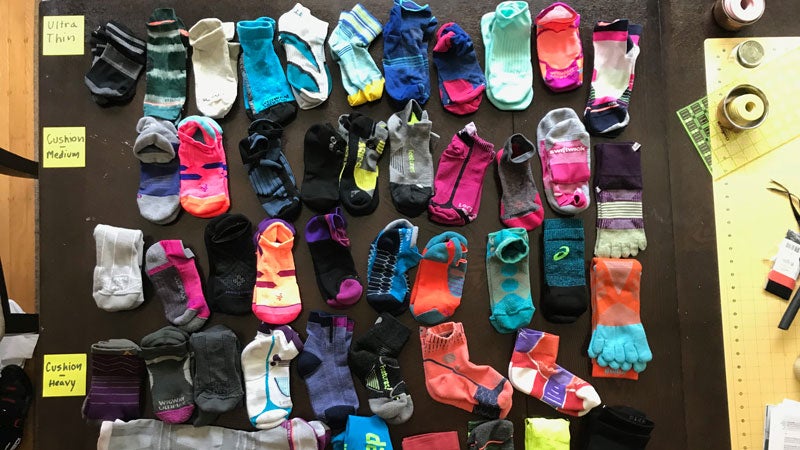
For this review, I recruited six experienced runners and gear testers, three men and three women, to evaluate 59 pairs of socks from 16 brands. The team included trail, road, and ultra runners, and we tested socks in Southern California, the mountains of Colorado,��the French Alps, and North Carolina.
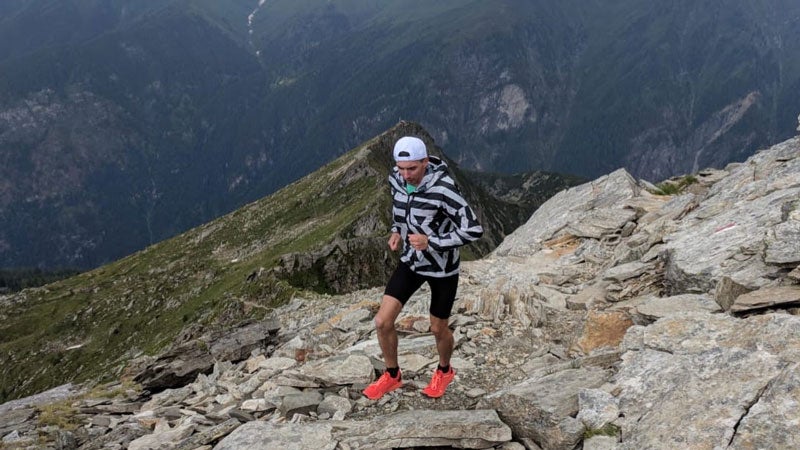
Each tester was instructed to spend as much time as possible��running, hiking, biking, and walking in each pair and name��12 top socks. The testers were further asked to make note of the best socks in several subcategories. Once each tester narrowed down his or her top 12, I compiled their rankings, checked their observations against my own findings, and included in this review the socks with the most votes.
How to Choose a Pair of Running Socks
Socks, while not the sexiest pieces of running gear, are pretty important. Think about it—multiple fabrics tightly woven together, capable of wicking moisture and withstanding an incredible amount of friction, designed to perfectly fit countless foot shapes and sizes.
Purchasing a good pair of running socks is easy, as long as you avoid cotton, which absorbs moisture, leaving your feet wet and more susceptible to blisters and hot spots. Unfortunately, wool and synthetic socks are more expensive than cotton. The typical price range for a single pair of performance running socks is $13 to $20, with compression socks reaching upwards of $60 per pair. To help save you from a painful trial-and-error process, we’ve compiled a list of four criteria to consider.
Thickness
Socks come in thicknesses ranging from ultra-thin to ultra-cushioned. Companies will typically indicate the thickness of a sock in the model name or on the packaging. Thickness is a matter of personal preference, but it is extremely important to match the thickness of your socks to your running shoes. Where possible, aim to try on socks in person before buying.
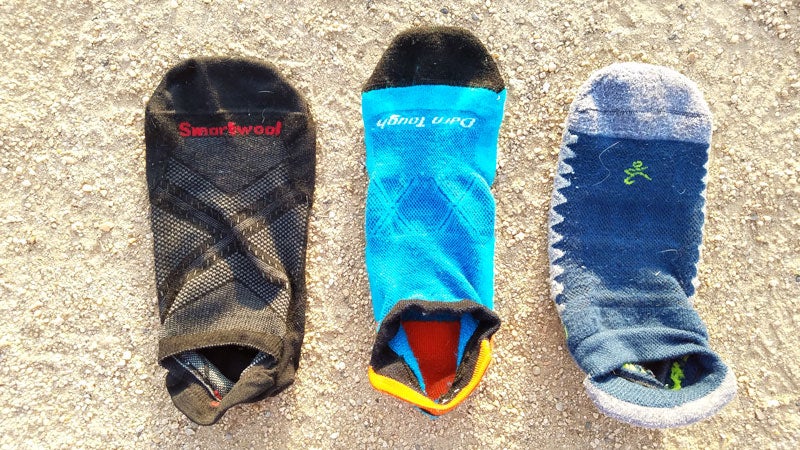
In general, thin socks will fit tighter and breathe better, so they’re more suited for hot days. Less fabric between your skin and the shoe gives you a better connection with the shoe. This is why I prefer thin socks for fast road running and trail descents when I’m pivoting through technical terrain. I generally find thicker socks more comfortable for most other running circumstances, as the thicker fabric adds a soft cushioned touch.
Fabric
Understanding the minute details, such as the exact ratios of wool to polyester or whether some particular sock has 5 percent versus 4 percent, is not important. It is important to buy socks made with performance fibers, which wick sweat away from your feet and reduce the odds that you’ll develop blisters.
The three main performance fibers are wool, polyester, and nylon, and nearly all performance running socks on the market today use a blend with at least one of those fibers. This way, sock makers can��mix and match performance characteristics, optimizing for stretch, say, or wicking. Of the 59 socks we tested, all but four employed at least three fibers.
Fit
A properly fitting sock should be snug around the heel, midfoot, and arch. Tension should ease a bit toward��the toes, allowing them to splay naturally. Wearing socks that are too tight around the toes can create hot spots from skin-to-skin friction.
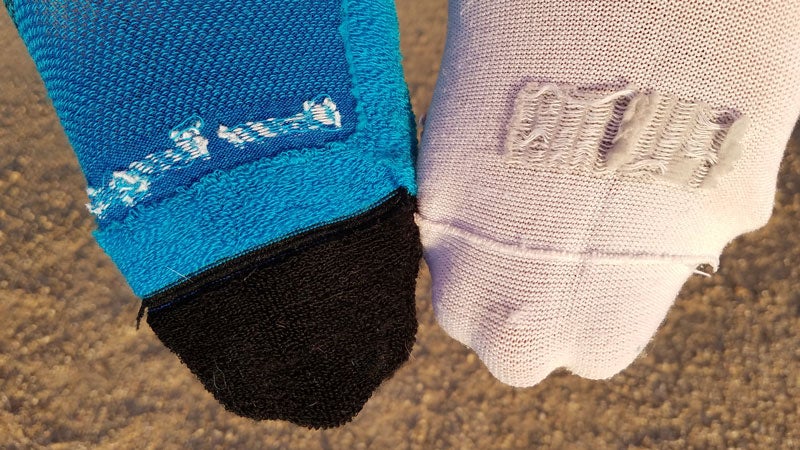
Today��most running-specific socks are seamless, and every sock we tested used seamless stitching. Always avoid overlock seams, which you can identify by turning the socks inside out. If you see��a raised ridge around the toes, choose a different pair.
Some socks are specially designed to enhance fit. The most common type in this group is anatomically cut, meaning there’s a��designated right and left, or the��socks are cut to the shape of your foot. Another special consideration is built-in support, most often seen around the arch. Makers will blend in stronger, directional fabric to add structure. A more distinctive and rather niche fit is the toe sock, popularized by the brand Injinji. Some runners swear by the glovelike separation of the toes for preventing blisters.
Height
Socks are offered in a wide variety of heights, also called cuts, defined by where the top of the sock sits on your leg. While terminology for a sock’s cut will vary from brand to brand, we generally feel there are four distinct categories: no-show, mid-crew, crew, and knee height.
No-Show
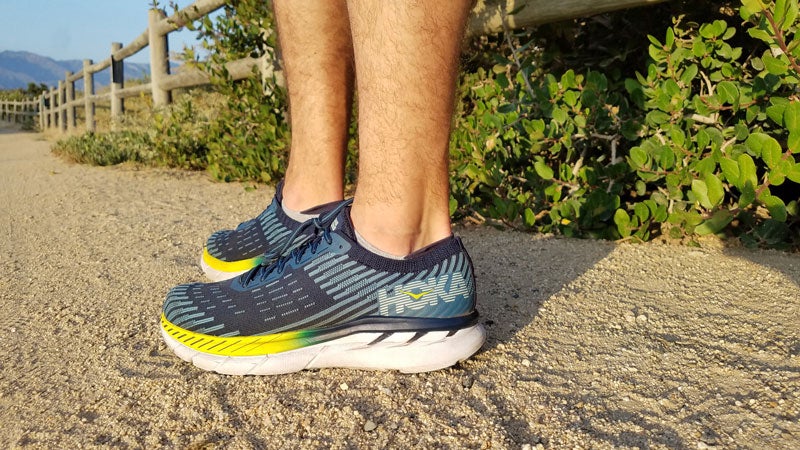
No-show socks, such as the��Balega Hidden Dry (pictured above),��sit aligned with the shoe’s ankle collar, leaving the ankle exposed. For trail runners, this low ankle cut can pose a few challenges. First, dirt and debris can more easily find its way between your skin and the sock, increasing the chances of irritation. It also lacks the leg protection of taller socks, which would guard against scrapes from low-lying plants and trail obstacles. Road runners, on the other hand, can benefit from an exposed ankle that can freely breathe.
Mid-Crew
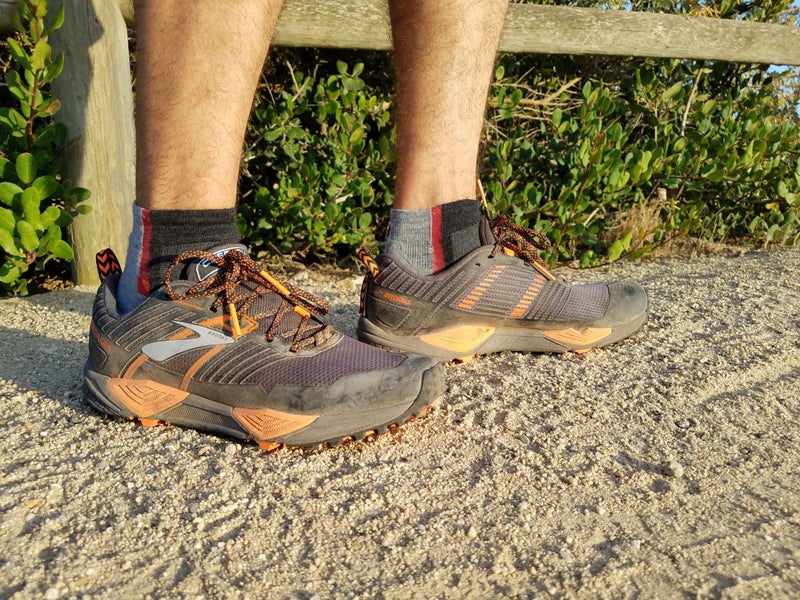
Actual height will vary quite a bit depending on the brand, but mid-crew socks may rise from just above the ankle to an inch or so below the calf. Also known as one-quarter crew, half crew, three-quarter crew, or low cut, mid-crew socks are a great option for trail runs because, unlike no-show socks, they’ll ward off dirt and debris��but still sit low enough to avoid overheating.�� [/photo]
Crew
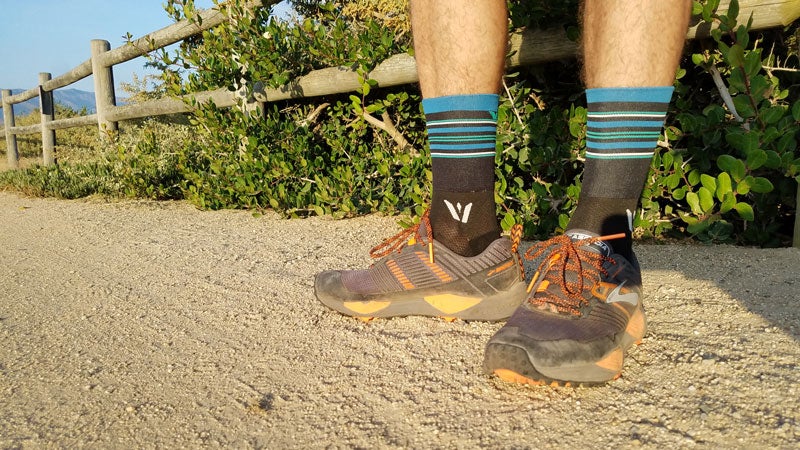
Crew socks sit just below the calf and are generally favored by trail runners and fashion-conscious road runners. The height adds some protection on the trails while allowing sock makers to get creative with design and coloring.
Knee
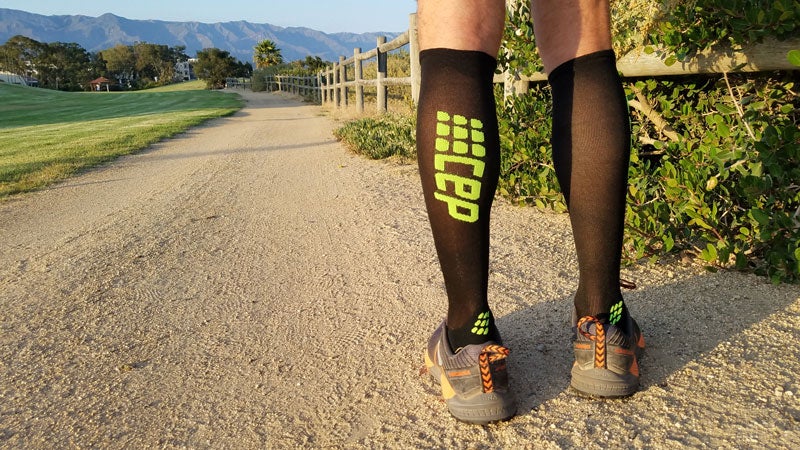
Most socks that fit up to the knee are compression socks. Originally designed to prevent blood clots in��hospital patients, compression socks are now used by athletes in an effort to optimize blood flow from the legs back to the heart��and enhance recovery. In practice, they may have a small positive effect on performance.


